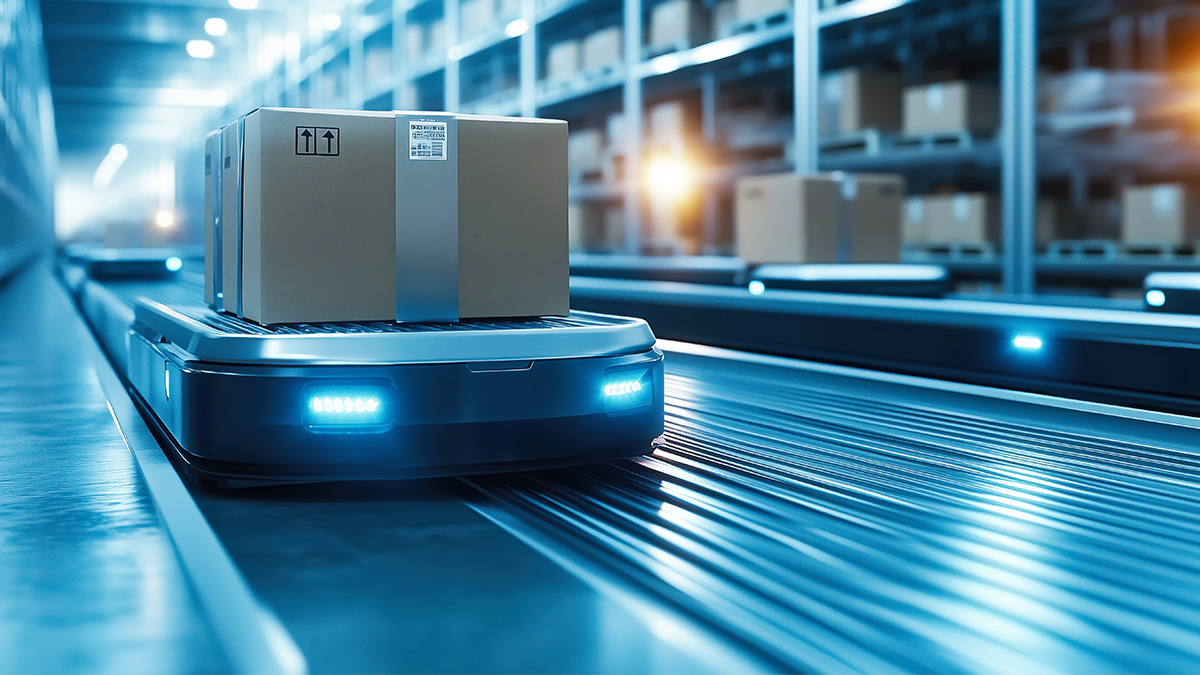Retail Robotics Are Here: From Warehouses to Delivery

Times are changing and retail robotics are here to transform every part of the shopping experience.
The retail experience isn’t what it used to be — it is whatever consumers want it to be. People are browsing while sitting on their couches. Everyday commodities like soap or paper towels are automatically appearing on their doorstep at regular intervals. Brick and mortar retailers are also stepping up the customer experience by automating processes in physical stores and providing customers the omni-channel experience they have online, along with improving operational efficiency.
The retail robotics market is expected to witness a growth of nearly 32% between 2024 and 2031, reaching $181 billion, according to Verified Market Research. It's no wonder. Retailers are using robotic automation to serve in a variety of store functions, such as inventory management, warehouse operations and customer experience enhancement. Humans and robots are fusing into a cohesive workforce, which augments the specific skillsets of both parties.
The International Federation of Robotics (IFR) reports that demand for human-robot collaboration is growing at a rapid clip. More than 205,000 service robots were installed in 2024, a 30% increase over 2023, with demand highest in the hospitality and transportation and logistics industries.
As autonomous retail robots make their way into storefronts and fulfillment centers, what will the future of retail look like? Here are five noteworthy areas of improvement:
1. A Stronger Omni-Channel Strategy
As a part of their omni-channel retail solutions, many stores are offering an “online-to-offline” option, which allows customers to order a product online, then drive to the store to pick it up. Although more convenient for customers, it can swallow valuable time for retailers.
Let’s walk through the process: say a customer orders shampoo, a bag of rice and a pack of double-A batteries. Because these are all in three different areas of the store, it would take an employee several minutes to fulfill this simple order. But pick-assist robots can instantly determine the quickest route to each item and carry out the task in a fraction of the time.
Autonomous retail robots can also help brick-and-mortar stores with a serious problem: data gathering.
Data is essential to store operations. It can determine whether a customer makes a purchase or returns to the store. Although online retailers can easily gather information on specific customers, it’s much more difficult for physical stores to keep track of what a customer bought and when. However, as robots monitor these metrics, it will holistically help physical stores fill in the gap between online and physical stores.
2. More Efficient E-Commerce Solutions
In 2012, Amazon started a “Big Bang” in Goods to Person (G2P) robotics when it acquired Kiva Systems. At the time, Kiva’s robots and inventory management system were reinventing the picking and packing process at large warehouses. Now, Amazon leads a fleet of 80,000 autonomous robots, an essential component of their e-commerce strategy.
Ultimately, the goal of leveraging these robots is to minimize congestion through an even distribution of traffic across the field. Therefore, in addition to tweaking the robots’ routes, the system can switch the chute assignments around to match demand, so that neither the robots nor the human sorters they work with hit any bottlenecks.
This was just the start of warehouse automation. Many companies rushed to fill the gap Kiva left in the market, creating three categories of “behind-the-scenes” autonomous retail robots:
Pick Assistant with Autonomous Mobile Robot (PA-AMR): These are deployed as human-collaborative robots in existing warehouse infrastructures. The AMR base often includes vision and light detection and ranging (LiDaR) for navigation.
Autonomous Mobile Robot (AMR): Like the PA-AMR, these are predominantly used in existing warehouse infrastructure. They move pods (shelves) to a pick and pack station.
Automated Storage and Retrieval System (ASRS): These are primarily deployed in new warehouses and include high-speed shuttle systems. They are excellent for retrieving medium- to high-density goods.
Given the struggle retailers face with last-mile delivery, these autonomous robots can also run micro-fulfillment centers or automated warehouses squeezed into dense urban areas. This will allow low-margin businesses to cut last-mile costs.
3. Enhance the Customer Experience
In a paper published in 1998, B. Joseph Pine II and James H. Gilmore argued that we have entered the “experience economy.” In other words, people aren’t just buying products; they’re buying an experience, and the retailer that can offer the most convenient and memorable experience wins.
This theory aligns with the priorities of retail decision-makers. According to a Jabil survey, almost 90% of retail decision-makers are investing in technology to improve the customer experience. Similarly, LinkedIn reports that 330 people in the U.S. list “chief experience officer” as their job title, compared to 125 in 2015.
But simply adding a hot title to the C-suite isn’t enough to make profit-raising improvements. Instead of focusing on high-level decisions, it often requires getting into the weeds of everyday operations, meeting the customer on the retail floor with out-of-the-box solutions. Hence, the creation of social retail robots that can meet and greet customers, provide information, collect feedback and act as shopping assistants that recommend products to customers based on their unique requirements.
Lowe’s helped lead the charge in implementing customer experience-focused robots when they launched the “LoweBot,” an autonomous retail service robot, in 2016. This robot, which speaks multiple languages, is essentially a rolling kiosk that helped customers navigate the store. It can lead them straight to the products they’re looking for as well as check shelves for misplaced or out-of-stock inventory.
Looking to provide a more human-like feel to their customer-serving robots, more than 2,000 companies around the world have adopted Pepper, a humanoid robot that can recognize faces and basic human emotions. Pepper can recognize return customers and interact with them in a personalized and dynamic way, speak 15 languages, offer directions, help customers who ordered online to pick up, as well as gather data to enrich analytics and generate shopper insights.
4. Improve In-Store Operations
Our survey responses show that inventory management is a high priority for retail decision-makers. Close to 70% of retail decision-makers are implementing or considering inventory accuracy systems, and more than 50% are investing in analytics to optimize channel and product inventory strategies.
Currently, the retail environment resembles a black box, with people constantly walking through, picking items off the shelf and placing them in their carts or putting them in the wrong place. As of now, there is no way to tell if an item is out-of-stock unless someone checks. In the meantime, out-of-stocks result in an average 4.1% annual revenue loss for grocers.
That is why retailers have started turning to robots for inventory management. For example, Badger Technologies’ autonomous retail robot is equipped with multiple cameras to scan store shelves and determine what items are misplaced or out-of-stock. This allows employees to save time; employees no longer have the tedious task of walking through the aisles to pinpoint out-of-stock items. It enables store employees to stay updated in real-time.
These robots can also patrol the store for potential hazards, such as a spill in aisle 10 or some apples on the ground in the produce section. This makes the retail environment safer for customers and allows employees to focus on more value-based tasks.
They also create an entire data set that doesn’t currently exist in average stores. Most retailers can’t track how a product moves through the store or pinpoint nearly the exact time that an item goes out of stock. However, this access to unprecedented data requires support from cloud-based platforms as well as leveraging developing technologies for optimal performance.
Artificial intelligence (AI) will not be just be a nice-to-have when it comes to autonomous retail robots. It will be fundamental. After all, as Gihad Jawhar, vice president of digital development at Lowe’s and the driver behind the company’s AI efforts, points out, “The technology doesn’t drive the solution. The problem drives the solution – and AI technology is a way to solve it.”
5. Make Deliveries Faster
Americans make about 1.1 billion car trips per day, and nearly 45% of those trips are taken for shopping and similar errands, according to the Bureau of Transportation statistics. That works out to around 500 million trips for routine errands every day.
In an economy where time is our most valuable (and non-renewable) currency, people are looking for ways to cut down on tedious like chores like running to the store for eggs or toilet paper. Hence, autonomous retail robots are not only used to enhance the efficiency of stores; they are also working to bring the store closer to the consumer.
A McKinsey report states that 15 years ago, the ratio of mail to packages was 13:1, but in another five years, the number of packages being delivered will be equal to the amount of mail. As they come to rely on parcel delivery more, people will also expect that delivery to become faster. FedEx pioneered overnight delivery, Amazon exploded with two-day delivery, and in the future, packages will be delivered in a matter of hours. Eventually, it may be even less.
That is why companies are turning to drone delivery. In fact, the commercial drone market in the U.S. was valued at $5.8 billion in 2018, but it stands to surge to $129.2 billion by 2025, a possible 56.5% compound growth rate, according to Grand View Research.
Now that Amazon Prime trucks have effectively taken over the roads, Amazon is exploring a new avenue for delivery: the sidewalk. The online retail marketplace has also been developing a fully electric delivery system called Scout. Scout is a cooler-sized autonomous delivery robot that rolls on the sidewalk to deliver Amazon packages to their intended destination. But companies may take this concept a step further with autonomous vehicles designed for delivery.
As advanced driver assistance systems (ADAS) progress, self-driving cars will also become a means of autonomous delivery. Already, Domino’s Pizza has teamed up with Ford to launch a research program for self-driving delivery vehicles. In this program, randomly selected residents of Ann Arbor, Michigan, can choose to have their pizza delivered by an autonomous Ford Fusion. This vehicle is fitted with an array of camera, sensors and a sophisticated LiDaR system. Roush Enterprises also created the Domino’s Heatwave Compartment for the vehicle, designed to keep the pizza warm while in transit.
But this isn’t the only application for autonomous delivery vehicles. Other stores (for example, grocery stores) can load orders into an autonomous vehicle and send them off to a specific address, eliminating the always-dreaded run to the store because something has expired or unexpectedly run out. Of course, these vehicles may look very different than the cars we recognize today, since their purpose isn’t to drive people; it’s to be a box on wheels.
Saying “the robots are coming” sounds very sci-fi and futuristic. But in actuality, it’s a natural evolution of available technologies and the experience customers are looking for. Autonomous mobile robots will completely change the retail industry, both for brick-and-mortar and e-commerce, filling the gap in last-mile delivery, improving operations and efficiency and creating a seamless and enjoyable experience for customers.
